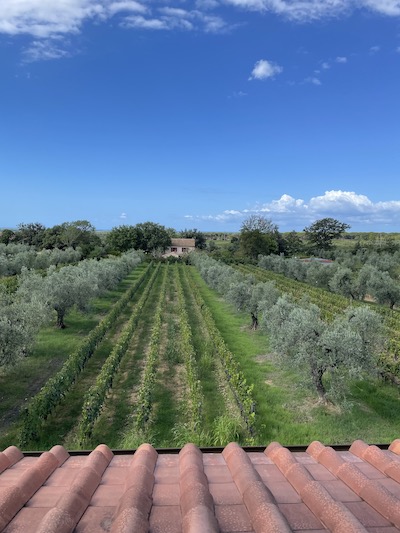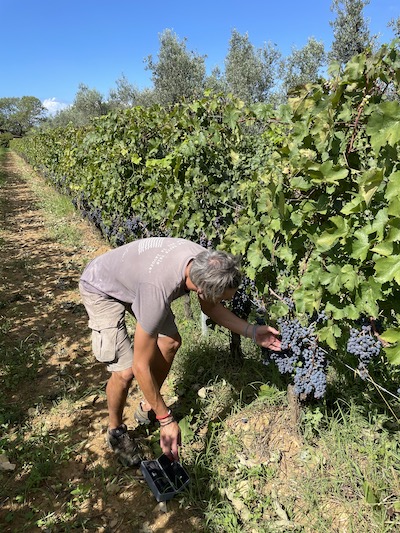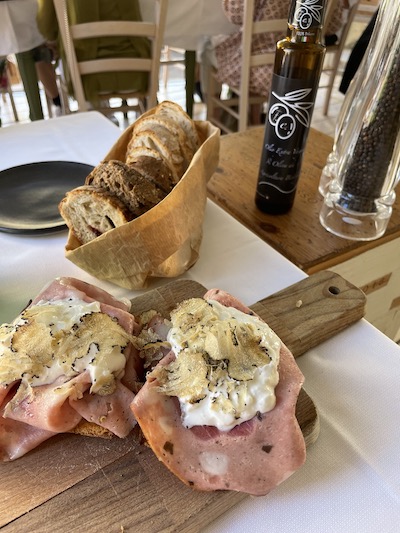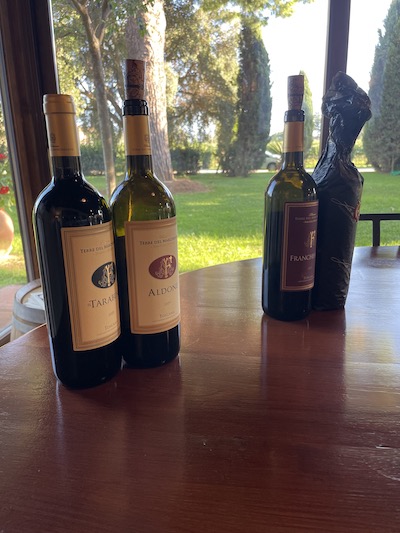In Wine on 14 Sep 2022
Thanks once again to M and his work, I had the opportunity to return to Florence — and this time, take a weekend trip to the Tuscan coast for a quick visit to Bolgheri. I have found Super Tuscans fascinating for about as long as I’ve known they exist (“ever since I knew they were real,” I suppose), and have wanted to do this trip for over a decade. In addition to breaking down in tears at the first sight of the coast at sunset I had several is this real life? moments over the course of our brief stay.




(I also couldn’t resist captioning every single photo on social media with “I’m here at my home in Tuscany.” I will never not find this funny and I am happy with my audience of the six or seven others in my life who agree.)
Bolgheri is not an easy place to book a tasting on short notice, even in September. While locals don’t particularly love the comparison, it’s hard to ignore the obvious Napa vibes: very beautiful and very fancy, with the vague sense that every minute you are there and your credit card is not actively being scanned, someone — somewhere — is losing money. Swiss license plates and top-notch carbon-fiber bicycles fill the streets, Sassicaia is poured by the glass in town, and winery tasting fees average €96-150. The wines can actually be quite affordable and, at this quality level, really represent tremendous value, especially by Napa standards. But by Italian standards, it feels much closer to a country-club ambiance than my experiences in Piemonte, Chianti and Montalcino, and I suspect folks like it that way.
(I also learned on this trip that saying you are a Master of Wine student in an inquiry email does not suggest to producers that you also work in the wine industry. Hosts were surprised when I mentioned working in wine as well as studying it. Make of that what you will.)
As in Napa, the wine is very good, and in just a few decades the producers here have earned the right to give off whatever vibes they want. For my part I chose to spend time at two (relatively) smaller estates, and I have no regrets.
Our first visit was to Chiappini, upon recommendation from production-side acquaintances. To say this estate is stunningly beautiful is both an understatement and a pretty unremarkable observation about anything in Bolgheri. But the interspersed rows of vines and olive trees, native grasses between the rows, and surrounding forest give Chiappini a wild beauty that, unsurprisingly, is accompanied by a genuine interest in promoting biodiversity.
Our lovely host Reina shared the estate’s history with us and provided a tour of the facilities, then mentioned that winemaker Alessandro Bonaguidi was around to answer any questions I might have. I was certainly not expecting to get to meet any winemakers given the timing of the visit (September 10), but this is an unusual year in Bolgheri: Chiappini’s harvest started two weeks ahead of schedule. We managed to catch Alessandro between white and rosé harvest and bringing in the Cabernet Franc, and he invited me to taste Cab Franc grapes from two adjacent rows. I understood then one of the big challenges of Bolgheri winemaking: wildly disparate ripening schedules even within the same variety and block due to sun exposure and other variances, necessitating attentive canopy management and extra sorting in the vineyard.
It’s hot in Bolgheri, but the proximity to the ocean brings cool daytime breezes and mercifully cool evenings. They get some rain in the fall, which is needed, but it can sometimes necessitate pushing back harvest a few days to allow grapes to dry out. With four great vintages back-to-back from 2018 to 2021 and 2019 looking like a classic year, I was told Bolgheri winemakers are hopeful for another home run in 2022. I asked about building wines for long-term aging, a key attribute in this region. Alessandro considers the most important factor in ageworthiness to be acidity, but he added that in Bolgheri vintage variation plays a noticeable role, so finding a new balance each year is critical.
On that note, I asked Alessandro if the increasing effects of climate change are more easy for young regions like Bolgheri to handle, because they’ve essentially grown up with these conditions. He nodded. “The body [of the wine] is out there in the ground,” he said, gesturing toward the vineyard — meaning the potential for big, ripe wines is now coming reliably from the growing conditions of the vintage. “We are responsible for the elegance.”
The Chiappini wines are delicious and a great value, with several I loved under €30. (They are also certified Organic, and their estate olive oil is exceptional.) One highlight for me was the Vermentino, which spends up to 48 hours on its skins to take advantage of their beautifully herbal aromatic potential. Tasting the Vermentino out of tank and then the 2021 bottled version was awesome: the tank sample already showed defined, precise mint and thyme notes and a beautifully round, full body. Lees contact gives it added texture, and after maturation in stainless steel, it’s got meat on the bones, a touch of minerality and those pretty fresh herb aromatics. It’s one of the better expressions of Vermentino I’ve ever had.
I could already taste the compressed layers of intense concentration in the 2019 Guado de’ Gemoli, their grand vin, made up of 70% Cabernet Sauvignon with Merlot and Cabernet Franc in the balance. But it’s very young and a gorgeous gush of fruit on the finish is the most it unfurled for me. I want to drink it in about ten years. Their entry-level blend, Ferruggini, was quite a contrast. It’s got 50% Sangiovese, 30% Cabernet Sauvignon and 20% Syrah, the combination resulting in a particularly woodsy, piney wine with potpourri and a lively beam of acid. Much less plush than the Merlot-based entry-level Bordeaux blends I’ve tasted, this 2021 wine matured in stainless steel was accessible in a different way: light on its feet and food-friendly.
After this delightful visit we had lunch in Bolgheri. I will remember my burrata with fresh white truffles and mortadella, pig-cheek and porcini tagliatelle, and glass of Sopaio Cabernet Franc as a very strong contender for a “last meal” should I ever have occasion to need one.
Our next visit, to Terre de Marchesato, came with many contrasts. 15 days ahead of schedule, they’d already harvested even their Petit Verdot, though there were a couple of amazingly sweet grape clusters still left on the vine for us to taste. The harvest equipment was clean and shining in the sun and the barrel cellar was quiet. So the majority of the visit was focused on tasting through four of their premium wines, accompanied by bread and house-made olive oil and a slow-motion video of what I can best describe as harvest ASMR.
Here, single-varietal bottlings are the name of the game. The focus is on the expression of the great Bordeaux varieties by their unique attributes, and we tasted their 2019s: Cabernet Sauvignon, Cabernet Franc, Merlot and Petit Verdot. I was impressed with all four. 2019 is clearly an amazing vintage, and the quality of these wines and their clear varietal characteristics really showed purity of fruit. It’s no surprise I loved the Franchesato, their Cabernet Franc; it had amazing complexity and concentration and I could have sipped it all day. M and I both loved the Petit Verdot, with its mint-leaf pyrazine and straight-laced checkerboard tannins. I haven’t had a single-varietal Petit Verdot I liked this much since South Africa.
Having blown my entire monthly wine education budget on two producers, I left Bolgheri with as much respect for the Super Tuscan philosophy as ever. I love traditional Italian grape varieties more than anything, but I believe anyone who thinks Italians should stick to their own grapes (a view I’ve occasionally heard expressed in the wine trade) must be imagining Italian wine as a much smaller world than the one I see. Great winemakers should always have the freedom to experiment and innovate, and the success they’ve had here speaks for itself.
Moreover, these wines will never not taste Italian to me — they have clear markers of Tuscan game and earth and savory Italian tannins that I find endlessly intriguing. I probably should not have been surprised that this region, the one that has looked to Bordeaux for inspiration and made Bordeaux’s grapes its own, would create a hospitality experience on the already well-touristed Tuscan coast that feels different from anything I’ve found so far in Italy. The wines are still (mostly) affordable, so I plan to enjoy them while I can.